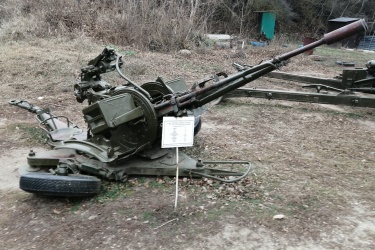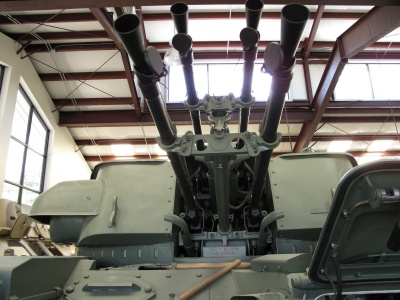Difference between revisions of "AZP-23 (23 mm)"
Inceptor57 (talk | contribs) m (→References) |
Inceptor57 (talk | contribs) m (→History) |
||
| Line 31: | Line 31: | ||
<!--''Examine the history of the creation and combat usage of the weapon in more detail than in the introduction. If the historical reference turns out to be too long, take it to a separate article, taking a link to the article about the weapon and adding a block "/History" (example: <nowiki>https://wiki.warthunder.com/(Weapon-name)/History</nowiki>) and add a link to it here using the <code>main</code> template. Be sure to reference text and sources by using <code><nowiki><ref></ref></nowiki></code>, as well as adding them at the end of the article with <code><nowiki><references /></nowiki></code>.''--> | <!--''Examine the history of the creation and combat usage of the weapon in more detail than in the introduction. If the historical reference turns out to be too long, take it to a separate article, taking a link to the article about the weapon and adding a block "/History" (example: <nowiki>https://wiki.warthunder.com/(Weapon-name)/History</nowiki>) and add a link to it here using the <code>main</code> template. Be sure to reference text and sources by using <code><nowiki><ref></ref></nowiki></code>, as well as adding them at the end of the article with <code><nowiki><references /></nowiki></code>.''--> | ||
===2A14=== | ===2A14=== | ||
| − | In 1954, the Soviet Union's Chief Directorate of the Missile Troops and Artillery GAU issued an order to the design bureau TsKB-14 (located in Tula) to develop a new anti-aircraft weapon that was larger than the 14.5 mm caliber and more transportable than the [[61-K (37 mm)|37 mm M1939 gun]].<ref name="Koll_23x152Bmm">Koll 2009, 195-200</ref> TsKB-14 designer Nikolay M. Afanasev, who was already working on upscaling his 12.7 mm [[A-12.7 (12.7 mm)|A-12.7]] aircraft machine gun to a 23 mm caliber, submitted his prototype weapon chambered in the 23x152 mmB cartridge used in the [[VYa-23 (23 mm)|VYa cannon]] (the | + | In 1954, the Soviet Union's Chief Directorate of the Missile Troops and Artillery GAU issued an order to the design bureau TsKB-14 (located in Tula) to develop a new anti-aircraft weapon that was larger than the 14.5 mm caliber and more transportable than the [[61-K (37 mm)|37 mm M1939 gun]].<ref name="Koll_23x152Bmm">Koll 2009, 195-200</ref> TsKB-14 designer Nikolay M. Afanasev, who was already working on upscaling his 12.7 mm [[A-12.7 (12.7 mm)|A-12.7]] aircraft machine gun to a 23 mm caliber, submitted his prototype weapon chambered in the 23x152 mmB cartridge used in the [[VYa-23 (23 mm)|VYa cannon]] (the cartridge modified to use steel case with a sturdier extractor rim). The cannon design was accepted for Soviet service under the GRAU index number ''2A14'' and began production at plant No.535 in Tula.<ref name="Koll_23x152Bmm"/> |
[[File:ZU-23-2_at_Aksai.jpg|x250px|right|thumb|none|A ZU-23 anti-aircraft gun with its ZU-14 mount deployed.]] | [[File:ZU-23-2_at_Aksai.jpg|x250px|right|thumb|none|A ZU-23 anti-aircraft gun with its ZU-14 mount deployed.]] | ||
Revision as of 01:53, 24 December 2021
Contents
Description
Write an introduction to the article in 2-3 small paragraphs. Briefly tell us about the history of the development and combat using the weaponry and also about its features. Compile a list of air, ground, or naval vehicles that feature this weapon system in the game.
Vehicles equipped with this weapon
General info
Tell us about the tactical and technical characteristics of the cannon or machine gun.
Available ammunition
Describe the shells that are available for the weapon and their features and purpose. If it concerns autocannons or machine guns, write about different ammo belts and what is inside (which types of shells).
Comparison with analogues
Give a comparative description of cannons/machine guns that have firepower equal to this weapon.
Usage in battles
Describe the cannon/machine gun in the game - its distinctive features, tactics of usage against notable opponents. Please don't write a "guide" - do not impose a single point of view, but give the reader food for thought.
Pros and cons
Summarise and briefly evaluate the weaponry in terms of its characteristics and combat effectiveness. Mark pros and cons as a list.
Pros:
Cons:
History
2A14
In 1954, the Soviet Union's Chief Directorate of the Missile Troops and Artillery GAU issued an order to the design bureau TsKB-14 (located in Tula) to develop a new anti-aircraft weapon that was larger than the 14.5 mm caliber and more transportable than the 37 mm M1939 gun.[1] TsKB-14 designer Nikolay M. Afanasev, who was already working on upscaling his 12.7 mm A-12.7 aircraft machine gun to a 23 mm caliber, submitted his prototype weapon chambered in the 23x152 mmB cartridge used in the VYa cannon (the cartridge modified to use steel case with a sturdier extractor rim). The cannon design was accepted for Soviet service under the GRAU index number 2A14 and began production at plant No.535 in Tula.[1]
The 2A14 cannon was envisioned to be used in single, twin, and quadruple-mount carriages. In February 1955, TsKB-14 designers E.K. Rachinskiy and R.Ya. Purtsen would produce the ZU-1 single mount and the ZU-14 twin-mount carriages for the 2A14, with evaluations for the designs held between April and September 1956. While the ZU-1 was eventually dropped due to its relatively high weight of 440 kg, the ZU-14 proved more successful at 950 kg fully loaded with the ability to transition from travel to combat configuration in up to 20 seconds (the weapon can still fire in the travel configuration). An automatic anti-aircraft sight ZAP-23 was also installed to help target aircraft flying up to 300 m/sec. Following troop trials in 1959, the ZU-14 was adopted in 1960 as the ZU-23 "Konkurent", with index number 2A13.[1]
The ZU-23 saw prominent service in the Soviet infantry units, notably in the airborne as the weapon was light enough to be air-droppable to have similar anti-aircraft firepower to a ZSU-23-4 "Shilka".[2] A Soviet airborne division would have a battalion of 18 ZU-23s, splitting to batteries of six ZU-23s for an airborne brigade.[3] The ZU-23 can provide an effective anti-air range of 2,500 metres, fed by linked ammunition of 50 rounds from boxes attached to the outside of each cannon's trunnion. The ZU-23 also saw use in Soviet motorized rifle regiments that have not yet converted to missile and ZSU-23-4 air defense, and as close air defense for SA-4 brigades.[2][3]
AZP-23
In 17 April 1957, the Soviet Council of Ministers ordered development of a radar-guided, self-propelled anti-aircraft system. When it was decided the development would split to a 37 mm system (known as the ZSU-37-2) and a 23 mm system (known as the ZSU-23-4), the development of a quadruple-mounted 23 mm cannon started to arm the ZSU-23-4. Using the 2A14 cannon as the basis, the weapon was modified to fit the vehicle's purpose with the adaption of a water-cooling jacket, an electrical sear mechanism, and a pneumatic charging mechanism. The modified 2A14 was designated the 2A7, most distinguished by its water-cooling jacket and weighing 85 kg (10 kg more than the 2A14's 75 kg). The 2A7 was mounted in the ZSU-23-4 in the "Amur" 2A10 quadruple mounting. The combination of the 2A7 and 2A10 was overall designated the AZP-23.
.Prototypes of the AZP-23 were produced at plant No.535 in 1963. Initial issues with the inhibited the weapon's reliability, with the fire rate so high from the combined four autocannons that the case ejection chutes were being clogged by fired casings. Other improvements were made to the barrel cooling, elevation and traverse mechanisms before the AZP-23 was submitted for trials. The AZP-23, along with its parent vehicle the ZSU-23-4, were soon put into production in 1964, with the first deliveries of the weapon system done in 1965. The AZP-23 was configured in the ZSU-23-4 with the RPK-2 "Tobol" radar system and with a total ammunition load of 2,000 rounds in the ZSU-23-4, with the top guns loaded with 480 rounds each and the bottom guns with 520 rounds each.[1]
In 1967, a series of improvements to the 2A7 was demanded by the Soviet Council of Ministers due to dissatisfied reception of the 23 mm. The barrel cooling had to be improved as well as the barrel life span (from 3,500 rounds to 4,500). The pneumatic charging system was found to be unreliable and was replaced by a pyrotechnic cartridge mechanism. The improved weapon was designated the 2A7M and was introduced in 1973 alongside the ZSU-23-4M.[1]
The AZP-23 cannon along with the RPK-2 "Tobol" radar would make up the ZSU-23-4 overall impressive anti-aircraft firepower, with a combined rate of fire of up to 4,000 rounds per minute from the four cannons and the radar able to lock-on and track targets up to 10 kilometres away (though the cannons effective range was still 2,500 metres). Comparisons with the American M163 Vulcan Air Defense System put the ZSU-23-4 in a favorable level of having a 66% greater effective range and almost 50% more accurate.[4] The AZP-23 and ZSU-23-4 were distributed as air defense battalions, with two platoons that had four anti-aircraft units each. This led to one platoon being equipped with ZSU-23-4 and the other with ZSU-57-2, and was later reorganized in the 1970s with the replacement of ZSU-57-2 with Strela-1 missile launchers.
The most prominent conflict the AZP-23 and ZSU-23-4 saw use in is the Yom Kippur War, where the combined air defense network of the Egyptians and Syrians forced Israeli aircraft down to the AZP-23's effective firing range, credited with 31 Israeli aircraft losses.[5] In other conflict like the Soviet-Afghanistan War and the Syrian Civil War, the AZP-23's rate of fire and elevation traverse range was effectively used to fight in mountainous and urban terrain respectively, the former conflict leading to the development of the ZSU-23-4M2 "Afghanskii" to carry more ammunition for the AZP-23 cannons.[4]
Media
See also
- ZSU-23-4 - The vehicle that mounts the AZP-23.
External links
References
- Citations
- Bibliography
- Department of the Army. 1991. FM 100-2-3: The Soviet Army - Troops, Organization, and Equipment. Washington DC: US Government Printing Office.
- Guardia, Mike. 2015. Self-Propelled Anti-Aircraft Guns of the Soviet Union. Great Britain: Osprey Publishing Ltd.
- Koll, Christian. 2009. Soviet Cannon: A Comprehensive Study of Soviet Guns and Ammunition in Calibres 12.7MM to 57 MM. Austria: self-published.
- Pike, John and Robert Sherman. 2000. "ZU-23 23MM Antiaircraft Gun". FAS Military Analysis Network. Last modified April 27, 2000. Website (Archive)
- Zaloga, Steven J. 1993. ZSU-23-4 Shilka & Soviet Air Defense Vehicles. Hong Kong: Concord Publications Company.
| USSR anti-aircraft guns | |
|---|---|
| 7.62 mm | Maxim's |
| 12.7 mm | DShK |
| 14.5 mm | KPVT |
| 23 mm | AZP-23 · ZU-23 |
| 25 mm | 72-K |
| 30 mm | 2A38 · ZK453 |
| 37 mm | 2A11 · 61-K · Sh-37 · Type 65 |
| 57 mm | S-68 |





